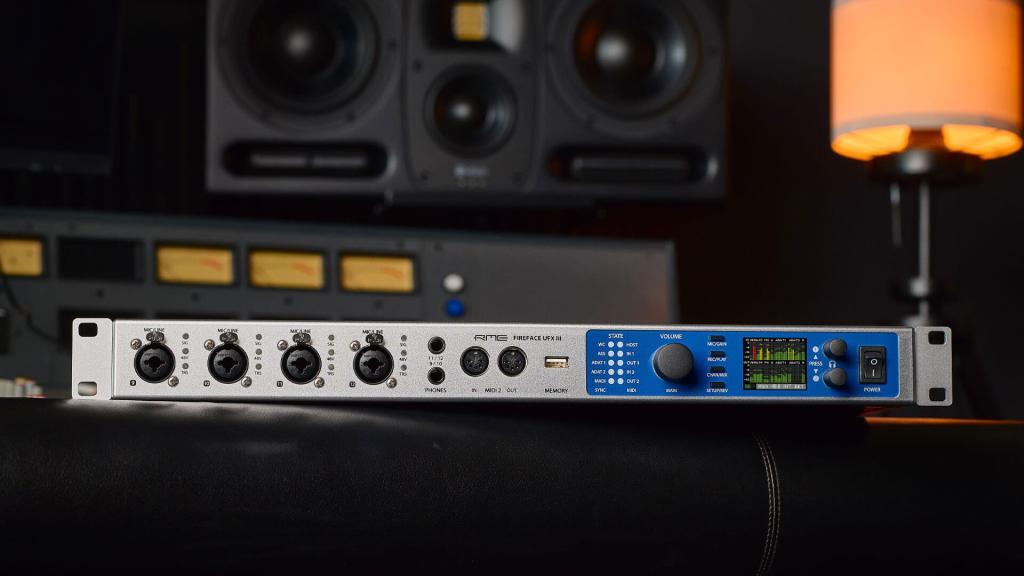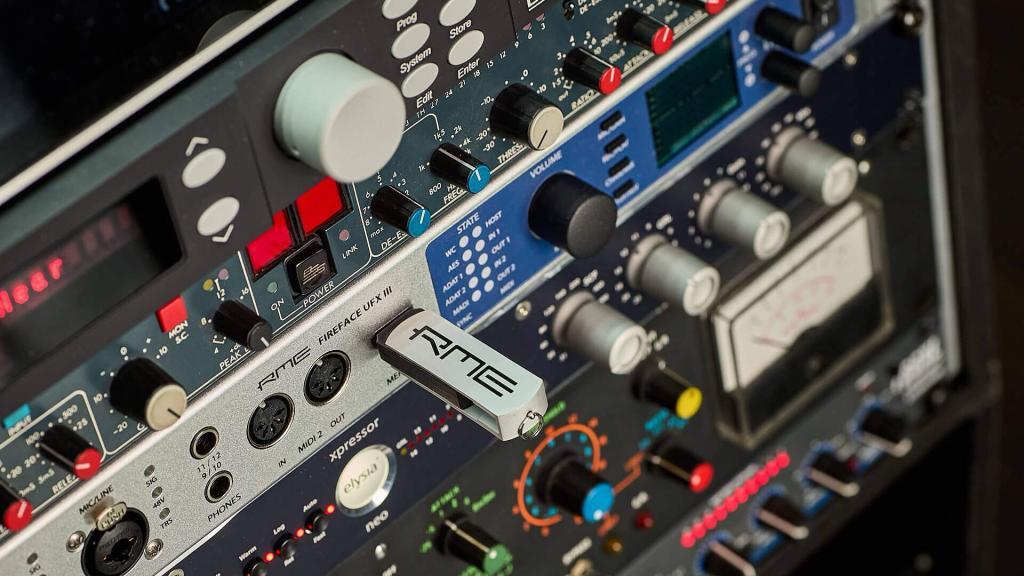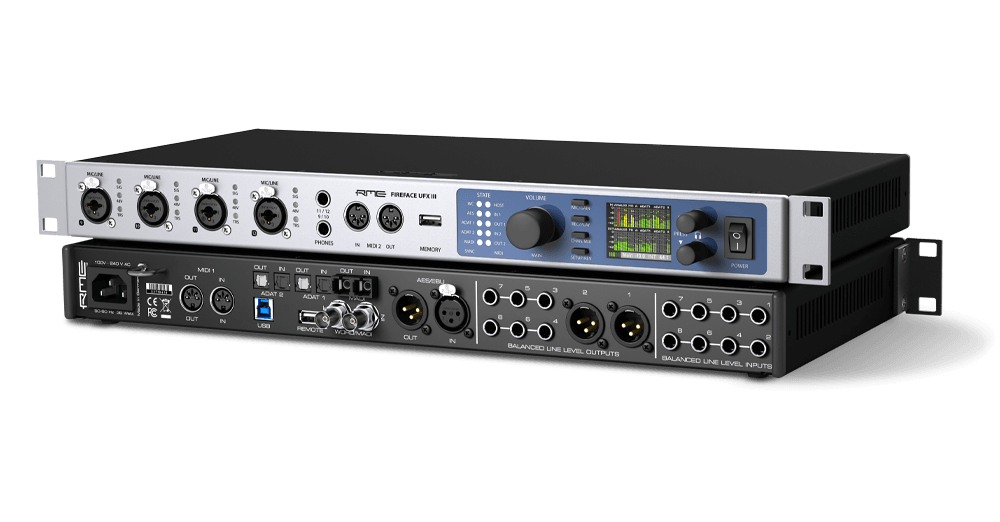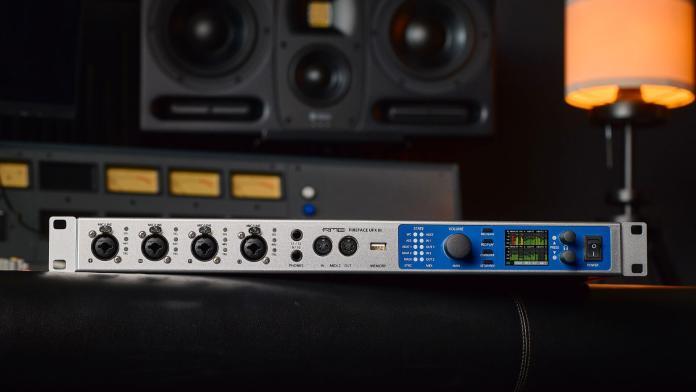Welcome to the next frontier in audio engineering technology—the RME Fireface UFX III. This state-of-the-art audio interface is the latest innovation in RME’s well-respected line of high-quality digital audio solutions. Building on the robust framework of its predecessor, the Fireface UFX II, the UFX III audio interface encompasses an impressive suite of features and capabilities designed to meet the ever-evolving needs of the modern music industry.

RME Fireface UFX III: Table of Contents
Incorporating both digital and analog inputs and outputs, MIDI capabilities, and a whole host of cutting-edge features, the RME Fireface UFX III seeks to redefine our understanding of music production technology. With its high-resolution audio quality, powerful performance, and unprecedented flexibility, the UFX III invites you to experience audio production like never before.
Rme Fireface UFX III state-of-the-art audio interface symbolizes a bold step forward, and the potential implications for music enthusiasts, producers, sound engineers, and musicians are vast and varied.
In an era where high-quality sound production is no longer confined within the walls of professional recording studios, the Fireface UFX III brings top-tier production capabilities to home studios, live performances, and mobile recording setups. Its advanced technologies cater to both the precision and creativity needed in contemporary sound design and music production.
As technology continues to drive evolution in the music industry, the RFE Fireface UFX III demonstrates a compelling vision of the future. It sets new standards, and in doing so, challenges the industry to not just keep pace, but to innovate, evolve, and always strive for better. By raising the bar, the Fireface UFX III ensures that our collective soundtrack will continue to be written in ever more vivid and varied soundscapes. This is not just the next chapter in audio engineering—it’s a whole new narrative.
Main Features of the RME Fireface UFX III Audio Interface
Detailed Overview of Analog Features
The RME Fireface UFX III carries forward RME’s reputation for excellence in analog I/O design, featuring a comprehensive range of inputs and outputs.
- Line In 1-8: The Fireface UFX III boasts eight balanced line-level inputs, accommodating a broad spectrum of audio sources. This feature offers superior flexibility for music producers and engineers in accommodating various instruments and sound devices.
- Microphone In 9-12: Equipped with four XLR mic preamps, channels 9-12 provide pristine audio capture. These dedicated microphone inputs, boasting low noise and high headroom, are designed to deliver exceptional quality and clarity.
- Instrument In 9-12: These same inputs, 9-12, also serve as high impedance instrument inputs. Whether plugging in guitars, keyboards, or other electronic instruments, users can count on the utmost clarity and character preservation.
- Line Out 3-8: Six balanced line-level outputs deliver robust audio playback. Whether routing to monitors, mixers, or other external processing, these outputs offer seamless interfacing with your studio gear.
- Stereo Monitor Output XLR (1-2): The Fireface UFX III provides stereo monitor outputs (XLR) on channels 1-2, offering high-quality audio for studio monitoring.
- Stereo Monitor Output Phones (9-12): In addition to the XLR outputs, channels 9-12 provide dedicated headphone outputs for comprehensive and flexible monitoring, a must-have for any serious audio engineer or producer.
In-depth Exploration of MIDI Capabilities
The RME Fireface UFX III embraces the versatility of MIDI, providing a rich array of control and synchronization options.
- MIDI I/O via 5-pin DIN jacks: The Fireface UFX III features both MIDI In and MIDI Out connections via standard 5-pin DIN jacks, facilitating seamless interaction with a myriad of MIDI-compatible devices.
- MIDI I/O via MADI: In a game-changing innovation, the Fireface UFX III also supports MIDI communication over its MADI interface, opening up fresh possibilities for MIDI data transmission and device integration.
Digital Specifications
As a flagship audio interface, the RME Fireface UFX III encompasses an impressive set of digital capabilities.
Clocking and Jitter Suppression Capabilities: The Fireface UFX III utilizes RME’s renowned SteadyClock FS technology. This feature ensures the highest precision in digital audio clocking and unrivalled jitter suppression, fostering immaculate audio fidelity.
Supported Sample Rates: Capable of handling sample rates up to 192kHz, the Fireface UFX III provides all the bandwidth you need to record and playback audio with astonishing detail and depth.
Digital Inputs and Outputs: The Fireface UFX III accommodates a comprehensive suite of digital I/O.
- MADI: For high channel count digital connectivity, MADI support offers up to 64 channels of digital audio via a single cable.
- AES/EBU: Traditional digital interfacing is also catered for with AES/EBU connectors.
- ADAT Optical: The interface supports ADAT, allowing for additional channels and compatibility with a wide range of digital gear.
- SPDIF Optical: SPDIF I/O provides further compatibility with digital audio equipment.
- Word Clock: Lastly, a Word Clock interface allows the Fireface UFX III to sync with other digital audio gear, ensuring optimal synchronization and timing across all devices.
Unpacking the Advanced Technology

RME has gone the extra mile in the design of the Fireface UFX III, ensuring every component and feature supports the highest level of audio performance. This section will delve into some of the advanced technologies that make the RME Fireface UFX III stand out in the competitive market of audio interfaces.
Explanation of Standout Features and Benefits
Effective Clock Jitter Influence: One of the defining features of the RME Fireface UFX III is the implementation of RME’s proprietary SteadyClock FS technology. This technology effectively neutralizes clock jitter, a common issue in digital audio that can degrade sound quality. With this feature, audio recording and playback remain pristine and unaffected by timing inconsistencies.
Galvanically Isolated Inputs: The RME Fireface UFX III incorporates galvanically isolated inputs, a key feature that protects against ground loops and electrical interference. This means that your audio signal stays clean and noise-free, regardless of the environment or equipment used.
High-Sensitivity Input Stage: The high-sensitivity input stage on the Fireface UFX III offers low-latency, high-headroom audio capture. This is crucial for recording dynamic sources like vocals or drums, where capturing the full range of volume and tonal nuance is paramount. The result is a more accurate and faithful audio reproduction.
Output Level Switchability: The ability to switch output levels on the Fireface UFX III ensures seamless integration with a range of devices. Whether connecting to professional studio monitors or consumer audio equipment, you can optimize the signal level to match, preserving audio integrity and avoiding signal clipping or distortion.
Implications for Music Production and Sound Engineering
The technological advances in the RME Fireface UFX III translate into significant benefits for music production and sound engineering.
For music producers, the Fireface UFX III provides a powerful, flexible hub for the recording studio. Its array of inputs and outputs cater to almost any audio source, while its high-quality preamps ensure that every detail of a performance is captured accurately. The device’s MIDI capabilities also make it a potent tool for controlling and synchronizing digital music equipment.
For sound engineers, the advanced jitter reduction, galvanically isolated inputs, and switchable output levels mean that the Fireface UFX III can deliver reliable, high-quality audio under a range of conditions. Whether working in a high-end studio, a makeshift recording space, or a live performance venue, engineers can count on the Fireface UFX III to perform consistently and deliver top-tier sound quality.
Comparisons and Use Cases
A cornerstone of any informed purchase, particularly in the domain of audio technology, is understanding how a new product compares with its predecessors and its competition. In this section, we will compare the RME Fireface UFX III with its predecessor, the RME Fireface UFX II, as well as similar products from competitors. Moreover, we will outline the most fitting scenarios in which the Fireface UFX III proves to be an essential asset.
Comparison with Previous Model (RME Fireface UFX II) and Competitors
While the Fireface UFX II was already an impressive audio interface, RME has further honed their design with the Fireface UFX III, adding a wealth of improvements and refinements. Among these, the most noteworthy are the implementation of SteadyClock FS for enhanced clock jitter reduction, galvanically isolated inputs for minimizing electrical interference, and the introduction of high-sensitivity input stages.
Compared to its competitors, the RME Fireface UFX III stands out in the realm of sound quality and feature sets. The total harmonic distortion (THD) and signal-to-noise ratio (SNR) specifications often surpass those of comparable audio interfaces. This is testament to RME’s ongoing commitment to deliver the highest quality audio performance to professionals and enthusiasts alike.
Ideal Use Cases for the RME Fireface UFX III
Music Production: The Fireface UFX III is an invaluable tool in the music production process. Its vast array of inputs and outputs, coupled with MIDI capabilities, allows for the integration of various instruments and audio devices into one streamlined setup. Its superior audio fidelity ensures that every nuance of a performance is captured with utmost accuracy.
Live Performances: Live sound engineers will find the Fireface UFX III indispensable. Its galvanically isolated inputs protect against electrical noise that can be common in live settings. The interface’s low-latency performance ensures that any live processing or effects will not be marred by delay, maintaining the seamless live experience.
Recording Studios: The RME Fireface UFX III is a dream come true for recording studios. Its high-sensitivity input stages and clock jitter reduction capabilities ensure the capture of high-fidelity, noise-free recordings. The large number of inputs and outputs enable the recording of large ensembles or multi-miked instruments with ease.
User Experience and Interface

Beyond the technical specifications and comparisons, one can’t overlook the importance of design, user interface, and the overall user experience. After all, an audio interface can possess all the features in the world, but without an intuitive design, the interface can become a frustrating hurdle rather than a facilitative tool. In this section, we delve into these aspects of the RME Fireface UFX III, which contribute to its practicality and convenience in music production and live performances.
Overview of Design and User Interface
The RME Fireface UFX III’s design is a testament to the harmonious balance between aesthetics and functionality. The sleek black exterior, coupled with a visually appealing LED-lit front panel, adds an air of professionalism to any studio setup. But more than just its looks, the thoughtful layout of controls and connectors ensures that operations are efficient and straightforward.
The Fireface UFX III’s user interface is designed with the user in mind. The bright, multicolored LED indicators provide a quick, at-a-glance overview of signal levels, ensuring the correct input gain and avoiding possible clipping. The interface’s high-resolution TFT display, paired with the detailed TotalMix FX software, provides access to all the device’s features in a visually intuitive and easy-to-navigate manner. This results in an efficient workflow, whether you’re in the studio or onstage.
Practicality and Convenience in Music Production and Live Performances
In terms of practicality and convenience, the RME Fireface UFX III excels. Its multiple inputs and outputs, coupled with high-resolution audio capabilities, mean that this interface can serve as the central hub in a variety of music production scenarios, simplifying setups and improving workflow. The physical design, with all main connectors conveniently located on the rear, maintains a clutter-free environment that enables focus on the music.
For live performances, the interface’s robust build quality ensures it can withstand the rigors of the road, while the direct operation via the interface’s rotary encoder or remotely via a web interface adds to the convenience. The DURec (Direct USB Recording) function is particularly useful in live settings, allowing for backup recording directly onto USB flash drives, thereby providing an added layer of safety against unforeseen circumstances.
The RME Fireface UFX III, with its user-centric design, advanced features, and practical layout, enables musicians, producers, and sound engineers to focus on what truly matters – creating and delivering the best possible music. Its versatility and adaptability make it an ideal companion for music production and live performances alike.
Read more about RME Fireface UFX III on RME Official Site.


